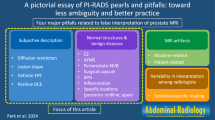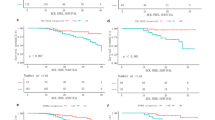Abstract
Purpose
To determine whether peripheral zone PI-RADS 4 observations can be further risk-stratified.
Methods
This was an IRB-approved HIPAA-compliant retrospective diagnostic accuracy study. Peripheral zone PI-RADS 4 observations prospectively identified at the study institution from 8/1/2015 to 12/31/2016 (n = 170 in 149 mpMRIs) were reviewed independently by two blinded genitourinary radiologists on the basis of (a) PI-RADS v2 shape, (b) pattern of peripheral zone sparing, and (c) rationale for PI-RADS 4 designation. Reference standard was targeted MR–ultrasound fusion biopsy and detection of Gleason 7+ prostate cancer. Positive predictive values (PPVs) were calculated. Predictors were assessed with binary logistic regression.
Results
PI-RADS 4 lesions with a DWI score of 4 were more likely to represent Gleason 7+ prostate cancer (p = 0.008–0.01; Reader 1 PPV: 53%; Reader 2 PPV: 48%). Pattern of peripheral zone sparing and most lesion shapes were not predictive (p > 0.05); however, oval lesions were predictive for Reader 1 (PPV = 59%, p = 0.03) and lentiform lesions were predictive for Reader 2 (PPV = 74%, p = 0.01). Lesions scored as “not meeting PI-RADS 4 criteria” had significantly lower PPV (p = 0.016–0.003; Reader 1 PPV: 14%, Reader 2 PPV: 16%).
Discussion
Peripheral zone PI-RADS 4 lesions with a DWI score of 4 are more likely Gleason 7+ cancer than those with a DWI score of 3. Lesions overcalled as PI-RADS 4 have PPV similar to published PI-RADS 3 data. Lesion shape and peripheral zone sparing in general do not predict Gleason 7+ cancer within PI-RADS 4 observations.



Similar content being viewed by others
References
Weinreb JC, Barentsz JO, Choyke PL, et al. (2016) PI-RADS prostate imaging—reporting and data system: 2015, version 2. Eur Urol 69(1):16–40. https://doi.org/10.1016/j.eururo.2015.08.052
Rosenkrantz AB, Ginocchio LA, Cornfeld D, et al. (2016) Interobserver reproducibility of the PI-RADS version 2 Lexicon: a multicenter study of six experienced prostate radiologists. Radiology 280(3):793–804. https://doi.org/10.1148/radiol.2016152542
Rosenkrantz AB, Babb JS, Taneja SS, Ream JM (2017) Proposed adjustments to PI-RADS version 2 decision rules: impact on prostate cancer detection. Radiology 283(1):119–129. https://doi.org/10.1148/radiol.2016161124
Mertan FV, Greer MD, Shih JH, et al. (2016) Prospective evaluation of the prostate imaging reporting and data system version 2 for prostate cancer detection. J Urol 196(3):690–696. https://doi.org/10.1016/j.juro.2016.04.057
Ahmed HU, El-Shater Bosaily A, Brown LC, et al. (2017) Diagnostic accuracy of multi-parametric MRI and TRUS biopsy in prostate cancer (PROMIS): a paired validating confirmatory study. Lancet 389(10071):815–822. https://doi.org/10.1016/S0140-6736(16)32401-1
Rosenkrantz AB, Oto A, Turkbey B, Westphalen AC (2016) Prostate imaging reporting and data system (PI-RADS), version 2: a critical look. Am J Roentgenol 206(6):1179–1183. https://doi.org/10.2214/AJR.15.15765
Westphalen AC, Rosenkrantz AB (2014) Prostate imaging reporting and data system (PI-RADS): reflections on early experience with a standardized interpretation scheme for multiparametric prostate MRI. AJR Am J Roentgenol 202(1):121–123. https://doi.org/10.2214/ajr.13.10889
Purysko AS, Rosenkrantz AB, Barentsz JO, Weinreb JC, Macura KJ (2016) PI-RADS version 2: a pictorial update. RadioGraphics 36(5):1354–1372. https://doi.org/10.1148/rg.2016150234
Hassanzadeh E, Glazer DI, Dunne RM, et al. (2017) Prostate imaging reporting and data system version 2 (PI-RADS v2): a pictorial review. Abdom Radiol (New York) 42(1):278–289. https://doi.org/10.1007/s00261-016-0871-z
McNeal JE, Redwine EA, Freiha FS, Stamey TA (1988) Zonal distribution of prostatic adenocarcinoma. Correlation with histologic pattern and direction of spread. Am J Surg Pathol 12(12):897–906
Augustin H, Erbersdobler A, Graefen M, et al. (2003) Biochemical recurrence following radical prostatectomy: a comparison between prostate cancers located in different anatomical zones. Prostate 55(1):48–54. https://doi.org/10.1002/pros.10216
Syed JS, Nguyen KA, Nawaf CB, et al. (2017) Prostate zonal anatomy correlates with the detection of prostate cancer on multiparametric magnetic resonance imaging/ultrasound fusion-targeted biopsy in patients with a solitary PI-RADS v2-scored lesion. Urol Oncol . https://doi.org/10.1016/j.urolonc.2017.04.011
Davenport MS, Khalatbari S, Liu PS, et al. (2014) Repeatability of diagnostic features and scoring systems for hepatocellular carcinoma by using MR imaging. Radiology 272(1):132–142. https://doi.org/10.1148/radiol.14131963
NiMhurchu E, O’Kelly F, Murphy IG, et al. (2016) Predictive value of PI-RADS classification in MRI-directed transrectal ultrasound guided prostate biopsy. Clin Radiol 71(4):375–380. https://doi.org/10.1016/j.crad.2016.01.001
Author information
Authors and Affiliations
Corresponding author
Ethics declarations
Funding
No funding was received for this study.
Conflict of interest
Matthew S. Davenport reports royalties from Wolters Kluwer. Prasad R. Shankar and Nicole E. Curci declare that they have no conflict of interest.
Ethical approval
All procedures performed in studies involving human participants were in accordance with the ethical standards of the institutional and/or national research committee and with the 1964 Helsinki declaration and its later amendments or comparable ethical standards.
Informed consent
The requirement for informed consent was waived, and institutional review board approval was obtained, for this Health Insurance Portability and Accountability Act-compliant retrospective diagnostic accuracy study.
Rights and permissions
About this article
Cite this article
Shankar, P.R., Curci, N.E. & Davenport, M.S. Characteristics of PI-RADS 4 lesions within the prostatic peripheral zone: a retrospective diagnostic accuracy study evaluating 170 lesions. Abdom Radiol 43, 2176–2182 (2018). https://doi.org/10.1007/s00261-017-1415-x
Published:
Issue Date:
DOI: https://doi.org/10.1007/s00261-017-1415-x




